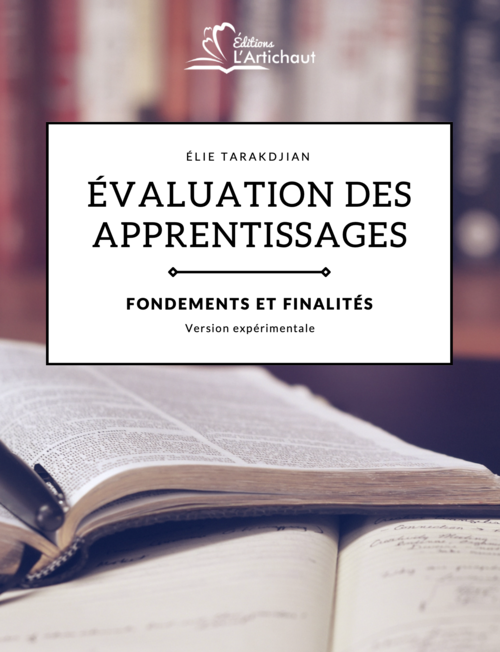In "Learning Assessment: Foundations and Purposes", Élie Tarakdjian presents a profound vision of educational renewal in Quebec, marking a significant shift in how teaching and learning are perceived and implemented.
Published by Artichaut Editions, this experimental work is part of a reflective approach centered on the student, emphasizing the importance of considering learners not only as passive receivers of knowledge but also as active participants in constructing their own understanding.
The first chapter addresses various types of knowledge useful for the teaching profession, divided into three main categories. These categories include observations of the school and sociocultural environment, experimental research on the act of learning, and the impact of these insights on teaching and learning. Tarakdjian explores concepts such as constructivism, socio-constructivism, connectivism, and the coherence between the training program and the new pedagogical paradigm, highlighting the inseparability of teaching, learning, and assessment.
The second chapter focuses on the assessment of learning. It differentiates between measuring and evaluating, providing a pragmatic definition of assessment and identifying four key elements to optimize evaluative interventions. This chapter also explores assessment in various contexts, including knowledge acquisition and skill development.
The third chapter is dedicated to the assessment process, focusing on planning. Tarakdjian discusses different types of assessment and ways of interpreting information, emphasizing the importance of pedagogical differentiation and its implications for teachers.
In the fourth chapter, the author delves into information gathering and regulation in the assessment process. This chapter deals with collecting information, sources of information, non-instrumented or spontaneous assessment, and the use of checklists as formative tools.
The fifth chapter addresses information gathering for summative purposes. Tarakdjian discusses specific tools such as questionnaires, evaluation grids, and interviews, focusing on Bloom's Taxonomy and its application in a competency-based approach.
The sixth chapter is devoted to interpreting and communicating evaluative information. It covers topics such as judgment and decision-making during learning, result communication, and the use of portfolios in the school context.
Finally, the seventh chapter examines the relationship between evaluative practices and student motivation. Tarakdjian explores the impact of these practices on student motivation, discussing the perception of the value of school tasks, competence, and controllability in the school context.
Throughout these chapters, Tarakdjian sheds light on the complexity of learning assessment, offering a rich and detailed guide for education professionals wishing to navigate this crucial yet often misunderstood field. His work emphasizes the importance of a holistic approach to education, where teaching, learning, and assessment are intricately linked and student-centered.
- ISBN: 978-2-924987-17-9
- Format: Digital Book
- Éditions L'Artichaut
- Élie Tarakdjian
Introduction
| Titre |
|---|
Couverture en couleurs |
Couverture |
Crédits |
Avertissement |
Contenu |
Contenu |
Introduction |
Chapitre 1
| Titre |
|---|
Chapitre 1 | page 7 |
Chapitre 1 | page 8 |
Chapitre 1 | page 9 |
Chapitre 1 | page 10 |
Chapitre 1 | page 11 |
Chapitre 1 | page 12 |
Chapitre 1 | page 13 |
Chapitre 1 | page 14 |
Chapitre 1 | page 15 |
Chapitre 1 | page 16 |
Chapitre 2
| Titre |
|---|
Chapitre 2 | page 31 |
Chapitre 2 | page 32 |
Chapitre 2 | page 33 |
Chapitre 2 | page 34 |
Chapitre 2 | page 35 |
Chapitre 2 | page 36 |
Chapitre 2 | page 37 |
Chapitre 2 | page 38 |
Chapitre 2 | page 39 |
Chapitre 2 | page 40 |
Chapitre 3
| Titre |
|---|
Chapitre 3 | page 53 |
Chapitre 3 | page 54 |
Chapitre 3 | page 55 |
Chapitre 3 | page 56 |
Chapitre 3 | page 57 |
Chapitre 3 | page 58 |
Chapitre 3 | page 59 |
Chapitre 3 | page 60 |
Chapitre 3 | page 61 |
Chapitre 3 | page 62 |
Chapitre 4
| Titre |
|---|
Chapitre 4 | page 79 |
Chapitre 4 | page 80 |
Chapitre 4 | page 81 |
Chapitre 4 | page 82 |
Chapitre 4 | page 83 |
Chapitre 4 | page 84 |
Chapitre 4 | page 85 |
Chapitre 4 | page 86 |
Chapitre 4 | page 87 |
Chapitre 4 | page 88 |
Chapitre 5
| Titre |
|---|
Chapitre 5 | page 109 |
Chapitre 5 | page 110 |
Chapitre 5 | page 111 |
Chapitre 5 | page 112 |
Chapitre 5 | page 113 |
Chapitre 5 | page 114 |
Chapitre 5 | page 115 |
Chapitre 5 | page 116 |
Chapitre 5 | page 117 |
Chapitre 5 | page 118 |
Chapitre 6
| Titre |
|---|
Chapitre 6 | page 153 |
Chapitre 6 | page 154 |
Chapitre 6 | page 155 |
Chapitre 6 | page 156 |
Chapitre 6 | page 157 |
Chapitre 6 | page 158 |
Chapitre 6 | page 159 |
Chapitre 6 | page 160 |
Chapitre 6 | page 161 |
Chapitre 6 | page 162 |
Chapitre 7
| Titre |
|---|
Chapitre 7 | page 179 |
Chapitre 7 | page 180 |
Chapitre 7 | page 181 |
Chapitre 7 | page 182 |
Chapitre 7 | page 183 |
Chapitre 7 | page 184 |
Chapitre 7 | page 185 |
Chapitre 7 | page 186 |
Chapitre 7 | page 187 |
Chapitre 7 | page 188 |
Bibliographie
| Titre |
|---|
Bibliographie | page 190 |
Bibliographie | page 191 |
Quatrième de couverture |
